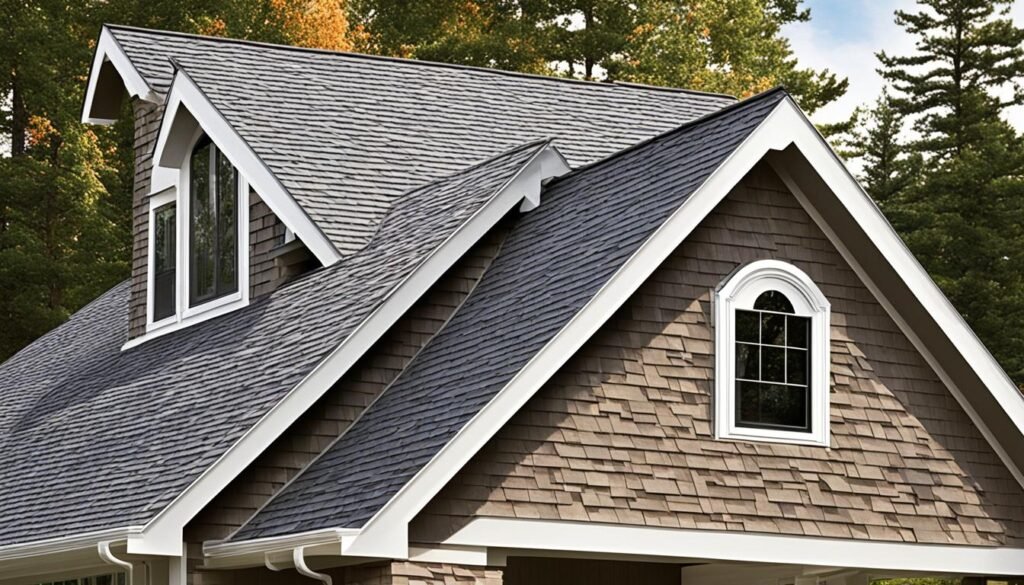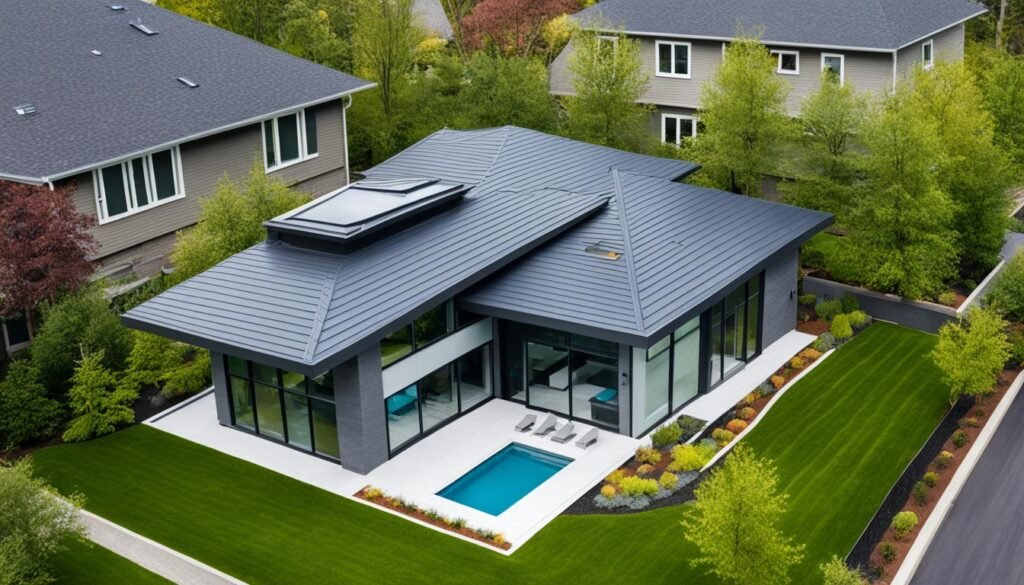Did you know over 80% of US homes have gable roofs? They are the most common roof style in the country. The roof you pick not only keeps your home safe but also defines its look. It affects your home’s energy use, how long it lasts, and how it looks. We’ll look at four popular roof styles. This will help you choose well for your home.
Key Takeaways
- Gable roofs are the most common roof type in the U.S. due to their simple design and cost-effectiveness, though not suitable for regions prone to strong winds or hurricanes.
- Flat roofs are a preferred choice for modern, minimalist home designs and commercial buildings, offering energy efficiency and flexibility.
- Hip roofs are durable and perform well in areas with strong wind and heavy snow, making them an ideal choice for such regions.
- Mansard roofs provide additional living or storage space and allow for future expansions, popular in French Renaissance architecture.
- Roofing materials like metal, concrete tiles, and EPDM can offer long-term durability and energy efficiency for your home.
Popular Roof Styles and Their Characteristics
Gable Roof
The gable roof is quite simple yet very popular. It forms an upside-down V, suitable for many house types. From Craftsman to Contemporary and Rustic, they are a fine match. Architects can change the pitch of the gables as needed, which adds to their versatility.
These roofs are good at shedding water, snow, and leaves. They also help ventilate the attic well. Their design and construction are usually easy and, therefore, cost less. But, in windy places, they might not stand up too well. If a gable roof’s frames are weak, they could sag under force.
Flat Roof
Flat roofs are often seen on big buildings, but they’re also used for houses. They’re almost level, which is different from the usual sloped roofs. While they look neat and modern, they’re not great at draining off rain and snow.
Modern homes often feature flat roofs. But, they can also add a touch of style to older houses. They work well above porches and garages. A big plus is that they make it easy to add heating and cooling systems. Yet, keeping them from water damage can be tricky. Because they don’t drain well, they could develop problems that are costly to fix.

“Flat roofs take a pounding from harsh weather, and with little to no pitch, water has no way of escaping, leading to corrosion and expensive roof repairs.”
Best Roof Shape: Evaluating Hip and Mansard Roofs
When picking a roof design, the hip roof and the mansard roof are popular choices. They have unique features that fit different climates and home styles.
Hip Roofs: A Sturdy and Versatile Choice
Hip roofs are common in bungalows, cottages, and Foursquare houses. They are known for their strength and durability. Their slope on all four sides helps them withstand strong winds and heavy snow.
This design also supports ventilation and may allow for large attics. Hip roofs work well with many materials. This includes traditional shingles, concrete tiles, and metal roofing. Concrete tiles enhance a hip roof’s look and protect against weather.
Mansard Roofs: Elegant and Functional
The mansard roof has a unique double-slope design. It makes a house look interesting and adds space on the upper levels. It’s a good choice for cold or stormy areas.
Mansard roofs can be expensive to build, but they boost a home’s value. They offer more living space and look great. Their shape helps deal with snow and wind, which is great for certain climates.
Choosing the right roof means thinking about your climate, budget, and style. Hip and mansard roofs both have their own benefits. They balance function, durability, and style for homeowners.

Conclusion
Choosing the right roof style is key. Consider the climate, your home’s design, and your budget. Each style brings its own look, good and bad points, and affects how your home looks and works. Knowing your options helps you pick a roof that boosts your home’s beauty, works well, and saves energy.
Roofs come in many shapes, like gable or flat. Pick one that matches your tastes and home style. Factors like weather, upkeep, and how it looks matter. Thinking about these things ensures your roof is both beautiful and protective for your home.
In the end, picking a roof shape is up to you. But, it greatly affects your home’s value and comfort. Think over your choices and get advice from experts. This way, you can pick a roof that’s right for you and improves your home’s look.
FAQ
What are the key features and benefits of a gable roof design?
What are the advantages and disadvantages of a flat roof?
What makes a hip roof a strong and practical option?
Source Links
- https://eagleroofing.com/2016/06/whats-right-roof-design-next-home-four-commonly-used-roof-designs/
- https://roofmaxx.com/2021/02/different-types-of-roofs/
- https://cedreo.com/blog/roof-styles/
- https://retipster.com/roofs/
- https://www.interlockroofing.com/blog/15-most-popular-roof-types-and-their-characteristics/
- https://contactcolonial.com/blog/different-types-of-roofs/
- https://southshorecontractorstampa.com/blogs/roof-types/
- https://roofingkettering.com/blogs/durable-roof-types/
- https://abestroofing.com/a-guide-to-roof-styles-for-oklahoma-homes-how-to-choose-the-best-option/
- https://shakeguys.com/roof-types/
- https://sterlingroofinggroup.com/types-of-roof-shapes/
- https://heavengables.com/types-of-roof-shapes/
